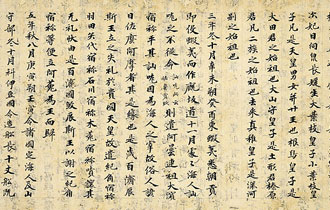Pages |
Furthermore, Hello Kitty and Pokemon come with an entourage of other merchandise, fitting them right at home in today's consumer culture. Murakami has blurred the boundaries of high and popular culture, by not only offering expensive art works but also relatively affordable handbags from Louis Vuitton.
But Murakami's work also has a darker side, as is seen in some of his own and many of his disciples' installations. His work can both celebrate and attack contemporary culture, showing the toxic aspects of consumer mania and cyberculture by offering visions of otaku who live antisocial lives, lost in the coils of the latest technological breakthrough. Ironically, perhaps, this dark side is something which also appeals to today's young people.
This is particularly true when it comes to anime and manga. When fans are asked what appeals to them particularly about anime and manga, several answers are common, from the beautiful art work to the intricate and absorbing stories. But one especially common answer is that many fans find that anime and manga offer a refreshing alternative to the Hollywood "happy ever after" mentality.
Many fans have commented on how amazed they were when they first saw a "good guy" meet with death, and how impressed they were by the elements of grief and tragedy that these Japanese media do not shy away from. In a world in which happy endings do not always happen, the challenging stories of anime and manga may seem more emotionally satisfying and, ironically, more "real" than the standard Hollywood feel-good formulas. In this regard, it is also worth noting the recent popularity of so-called J Horror, or Japanese horror films, which are considered not only more atmospheric and subtle than American horror movies but are tinged with a sense of melancholy that is perhaps more intriguing than the usual one-dimensional Hollywood slasher movie.
This brings us to another element behind Japanese pop culture's current popularity: the values that are exported along with the culture. This may be seen as a surprising assertion. Even many Japanese commentators have decried the fact that Japan is more known for products than values. The brilliant writer Murakami Haruki, for example, once lamented that all his country was known for was for cars and electronic equipment.
And yet, in my contacts with anime fans around the world, I have found that many of them will speak about how the ideas on which certain anime are based appeal to them as much as the story or art work. One element that seems particularly to appeal to contemporary young people is the fact that anime and manga present a more nuanced sense of good and evil than the often more simplistic visions given in American pop culture. Fans comment on how characters are usually presented three-dimensionally rather than as icons of heroism or villainy.
In military sagas, from samurai epics to science fiction visions, political situations and moral issues are often treated in genuinely complex terms. Other complex questions, such as the role of technology in our future lives, are also dealt with in an intellectually challenging yet nuanced manner, such as the issue of artificial life explored in the director Oshii Mamoru's beautiful film Ghost in the Shell.
Some anime offer positive messages on how to live. The most powerful of these are probably the works of Miyazaki Hayao, arguably the greatest living animator today. A director, writer and artist, Miyazaki creates richly detailed worlds in which believably human characters struggle with a variety of difficult issues, from faith (the manga Nausicaa), to the environment (Nausicaa, Princess Mononoke, Spirited Away), to how to come of age in a challenging world (Kiki's Delivery Service, Spirited Away, My Neighbor Totoro). Not surprisingly, his work is not only hugely popular in Japan but has garnered legions of fans throughout the world who refer to Miyazaki's ideas as templates for how to live a civilized life.
Pages |











